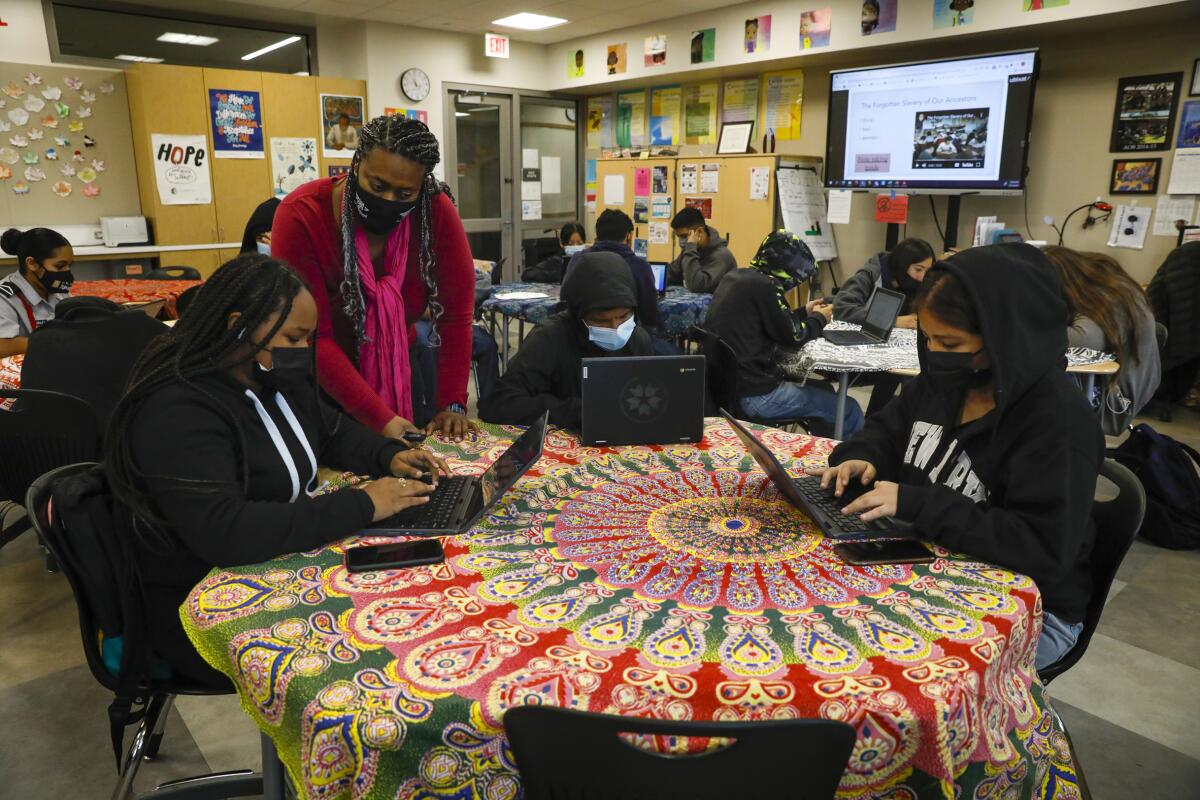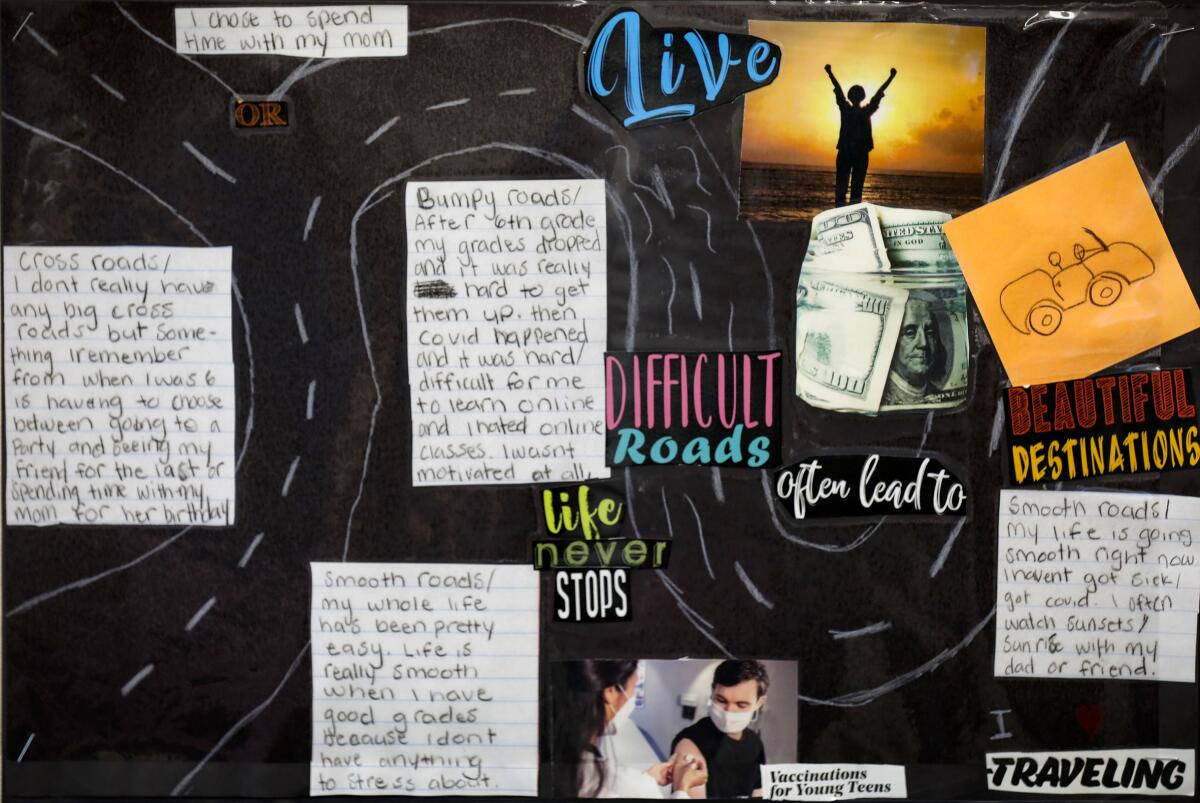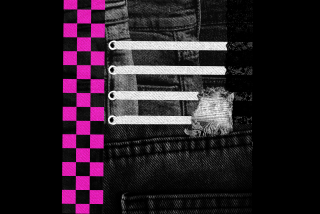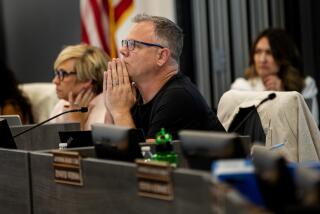San Diego students talk about racism, bias and privilege in ethnic studies classes

SAN DIEGO â On a recent rainy day in City Heights, Sharon Apple began her ethnic studies lesson with a question for students: What comes to mind when you think about slavery?
Many of the 25 Hoover High freshmen in the class typed the words âBlacks,â âchainsâ and âropesâ on their Chromebook laptops. Others typed âracism,â âpeople being sold and bought,â and ânot fair.â
âThatâs interesting that you all think about slavery like that,â she said after reading the words aloud. âBut did you guys know that slavery did not begin here in America with Africans?â Most of the students said âNo.â
This story is for subscribers
We offer subscribers exclusive access to our best journalism.
Thank you for your support.
âIt began with our Indigenous people ⌠here on this land. They were the first slaves here,â Apple continued. âWeâre going to look at the forgotten slavery of our ancestors, because what land are we on? ⌠Kumeyaay land.â
In ethnic studies classes across the San Diego Unified School District, high school students are learning about things rarely discussed in classrooms, such as the enslavement of Native Americans, the origin of the N-word, and the elements of implicit bias and privilege.
Thatâs the point of ethnic studies, teachers say, for students to see history from the perspectives of traditionally overlooked groups, especially African Americans, Latinos, Asian Americans and Native Americans. Itâs to scrutinize past and present injustices not usually discussed in typical school curriculum, teachers said.
âThere are uncomfortable truths in history that will sometimes make us feel bad, and that is what we call empathy,â said Wendy Ranck-Buhr, instructional support officer for San Diego Unified. âIf you donât know history, youâre bound to repeat it.â
Until now ethnic studies has been offered by a few local districts, but soon it will become mandatory for all California public high school students.
Last year, state leaders reached an agreement to make ethnic studies a graduation requirement starting with the Class of 2030, who will be entering high school in 2026.
At the same time, a national conservative push is underway to eliminate or regulate discussions about race and similar topics in schools. Parent groups and political figures claim it is critical race theory, which is a university-level discipline that deals with legal theory and examines how racial discrimination is perpetuated by the law.
Critics allege that ethnic studies and other school anti-racism efforts divide people, make generalizations about race, indoctrinate students in favor of liberal ideologies and make white students feel guilty.
Advocates and educators respond that ethnic studies is not about shaming students; itâs about uplifting them by promoting empathy and celebrating who they are.

Apple, who has been a teacher for more than two decades and was named a district teacher of the year last spring, said she teaches ethnic studies so her students can feel validated.
âI want my students to see value in themselves. I want them to know that theyâre worthy,â Apple said. âAnd when I teach them about who they are ⌠they know that theyâre not alone; they know itâs not just them going through the struggle.â
This is important for students of color, who make up three-quarters of San Diego Unified students but who often have not been taught much about the history of their predecessors, advocates say.
Ethnic studies for all
While outrage about ethnic studies surged in school board meetings and on social media this year, the program is far from new in San Diego Unified. Teachers have been teaching and expanding ethnic studies in the district over the past 14 years.
The district had its first version of an ethnic studies course in 2007 at Lincoln High School. The school had reopened after a major renovation and included an introduction to social justice course that teachers developed for the schoolâs Social Justice Academy. The course would become a precursor to ethnic studies.
In 2015 the San Diego Unified School Board decided to expand ethnic studies across the district and convened a committee of experts and educators to guide that expansion.
In 2019 the school board voted to make ethnic studies a graduation requirement, two years ahead of California officials who approved a law in October to make it a requirement statewide. San Diego Unifiedâs graduation requirement began with the Class of 2024, who are sophomores now.
Now San Diego Unified offers ethnic studies-influenced courses in English, world history and U.S. history in addition to its introduction to ethnic studies course.
The district plans to go even further with an initiative the school board approved last year called Ethnic Studies for All, which will infuse themes and teaching strategies of ethnic studies into curricula in all grade levels, said Ricardo Medina, a San Diego Unified ethnic studies resource teacher.
âI want them to know that theyâre worthyâ
At Hoover High, Apple showed her class a 12-minute video about the European enslavement of Indigenous people in the Americas, which lasted from the 15th to the 19th centuries. Then she asked students what they thought, felt and wondered about the video.
One student asked why people would want to be in power over other people. Another student wondered why Indigenous slavery wasnât mentioned in school textbooks. A third student asked âhow everything ended.â
Apple posed more questions to her class for them to research: Why did it take so long to end Indigenous enslavement in the U.S.? And why is Indigenous enslavement not widely known or discussed?
âThis is the whole purpose of what ethnic studies is supposed to do, right?â Apple said to the class. âWhen we talked about this idea of racism, remember, we talked about that they excluded some stories of people who werenât part of the dominant culture, and this is a story that was excluded ⌠And so weâre bringing it back, right, weâre giving you the whole story, not just parts of it. ⌠It honors the struggles of our Indigenous peoples.â
Her students also took a test written by researchers to detect implicit bias and learned about microaggressions, which are subtle and often unintentional instances of stereotyping, such as assuming an Asian-American person was born in another country.
Apple had the students read Jamaica Kincaidâs short story âGirlâ and write a similar piece from their own perspective about times they have been stereotyped.
In a class activity about privilege, Appleâs students went to stations in the classroom where they were asked to take a bead for each of a list of statements that applied to them, such as: âI have never wondered where my next meal would be coming from and when,â âI do not worry about getting paid less than my colleagues based on my gender,â and âI have not and do not fear people finding out my sexual orientation.â
Afterward, students examined how many beads they each had. Students then discussed what privilege is and how one person might use their privilege to help others.
More to Read
Sign up for Essential California
The most important California stories and recommendations in your inbox every morning.
You may occasionally receive promotional content from the Los Angeles Times.











